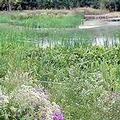 可能很難想像在曼哈頓的市郊,紐約市仍然保有濕地, 1月30日紐約市長彭博(Michael Bloomberg)發表的一份報告中指出,濕地保護這個城市,而現在卻同時也需要被保護。
可能很難想像在曼哈頓的市郊,紐約市仍然保有濕地, 1月30日紐約市長彭博(Michael Bloomberg)發表的一份報告中指出,濕地保護這個城市,而現在卻同時也需要被保護。
「許多紐約客從不知道在紐約的五個區當中,有上千畝的濕地存在,」彭博說,「濕地是健全的生態體系,擁有調節氣候的重要功能,例如過濾污染物、調節暴雨水逕流、隔離二氧化碳與緩和暴風雨災情等。」
今日紐約市只有保有過去1%的淡水濕地和10%的潮汐濕地。這些現有的潮汐濕地主要集中在布魯克林牙買加灣沿岸、皇后區和史坦頓島,該島同時也擁有淡水濕地。
小於12.4英畝的淡水濕地不受州法律的保護,也不在聯邦保護範圍之內,因此特別需要關注。這份新的報告指出,人們不太認識紐約市中像這樣的小型濕地規模的情況。
這份報告建議開發新的高解析度航空及衛星的濕地地圖,以收集更多關於小型淡水濕地的訊息,在尋求其他在報告中提及的選項之前,要明確地瞭解未經保護濕地的大小及位置,這份地圖預計在今年開始著手製作。
「在『規劃紐約』(PlaNYC)的願景裡,我們承諾要研究濕地,並要建立像環保局管理的史坦頓島藍帶暴雨計畫(Staten Island Bluebelt stormwater project)那樣的濕地成功案例。」彭博表示。
史坦頓島藍帶計畫是一個獲獎肯定的暴雨管理計畫,同時兼顧了生態平衡和成本效率,約佔了史坦頓島三分之一的面積,這個計畫保留了天然的排水通道,包括溪流、池塘含其他濕地區域,和傳統的下水道建設相比,節省了數千萬的建設成本。
這個研究也發現濕地最大的威脅並不是在於缺乏法規的保護,而是來自現有已被污染的濕地可能會被上升的海平面或是暴雨逕流的衝擊而受到破壞。
另外低窪的土地政策也因為海平面上升而更形重要,現今地表的水資源被許多州與聯邦法律法規所約束,但是紐約市缺乏一個完整的低窪土地的管理政策。
為了面對這些威脅,紐約市的氣候適應工作小組將會於2009年發表一份關於濕地的政策建議書。
紐約也正在探索其他可能的資金、貸款或是其他機制以改善濕地的保存和維護。
紐約市和其他市政當局可以要求州政府指定所有小於12.4英畝的濕地為「特別地方性重點保護區」,因此列為州政府的保護範圍。
這份報告是彭博市長的規劃紐約願景的127個承諾之一,可點選閱讀此份報告。
It's hard to image standing in midtown Manhattan, but wetlands do exist within New York City, and they both protect the city and need protection themselves, according to a report released Friday by Mayor Michael Bloomberg.
"Many New Yorkers don't realize there are thousands of acres of wetlands in the five boroughs," said Mayor Bloomberg. "Wetlands are robust ecosystems that perform crucial environmental functions like trapping pollutants, capturing stormwater runoff, sequestering carbon dioxide, and moderating storm surges."
Today, the city has only one percent of its historic freshwater wetlands and 10 percent of its historic tidal wetlands.
These tidal remaining wetlands are concentrated in Brooklyn around Jamaica Bay, in Queens, and in Staten Island, which also has freshwater wetlands.
Freshwater wetlands smaller than 12.4 acres are not protected by state law and are vulnerable to determinations that they are outside of the scope of federal protection.
The new report shows that the extent of these smaller wetlands in New York City is not fully known.
To gather more information on the smaller freshwater wetlands, the report recommends developing new high-resolution aerial and satellite wetland maps to precisely determine the size and location of unprotected wetlands before pursuing other options outlined in the report. This mapping is scheduled to start later this year.
"In PlaNYC, we promised to study wetlands and build on wetland successes like the impressive Staten Island Bluebelt stormwater project managed by the Department of Environmental Protection, as well as the thousands of acres of wetlands managed by the Parks Department," said the mayor.
The Staten Island Bluebelt is an award winning, ecologically sound and cost-effective stormwater management for about one third of Staten Island�s land area. The program preserves natural drainage corridors, including streams, ponds, and other wetland areas, saving tens of millions of dollars in infrastructure costs when compared to providing conventional storm sewers for the same land area.
The study also identifies threats to wetlands that are not from a lack of regulatory protection, but rather from the existing polluted or degraded condition of wetlands that may have been caused by rising sea levels and stormwater runoff.
In addition, submerged lands policy will be more important as sea levels rise in response to climate change. While open waters are subject to extensive state and federal regulatory protections, the city lacks a comprehensive submerged lands management policy.
To address these threats, the city's Climate Adaptation Task Force will release a report on policies for the adaptation of wetlands and other critical infrastructure later this year.
The city is also exploring alternative funding, mitigation banking and other mechanisms for improved restoration and maintenance of wetlands.
New York City and other municipalities in the state can request that the state designate any remaining wetlands below 12.4 acres to be of "unusual local importance" and thus within state protection.
Clickhere to view the report, which fulfills one of the 127 commitments in Mayor Bloomberg's PlaNYC.





